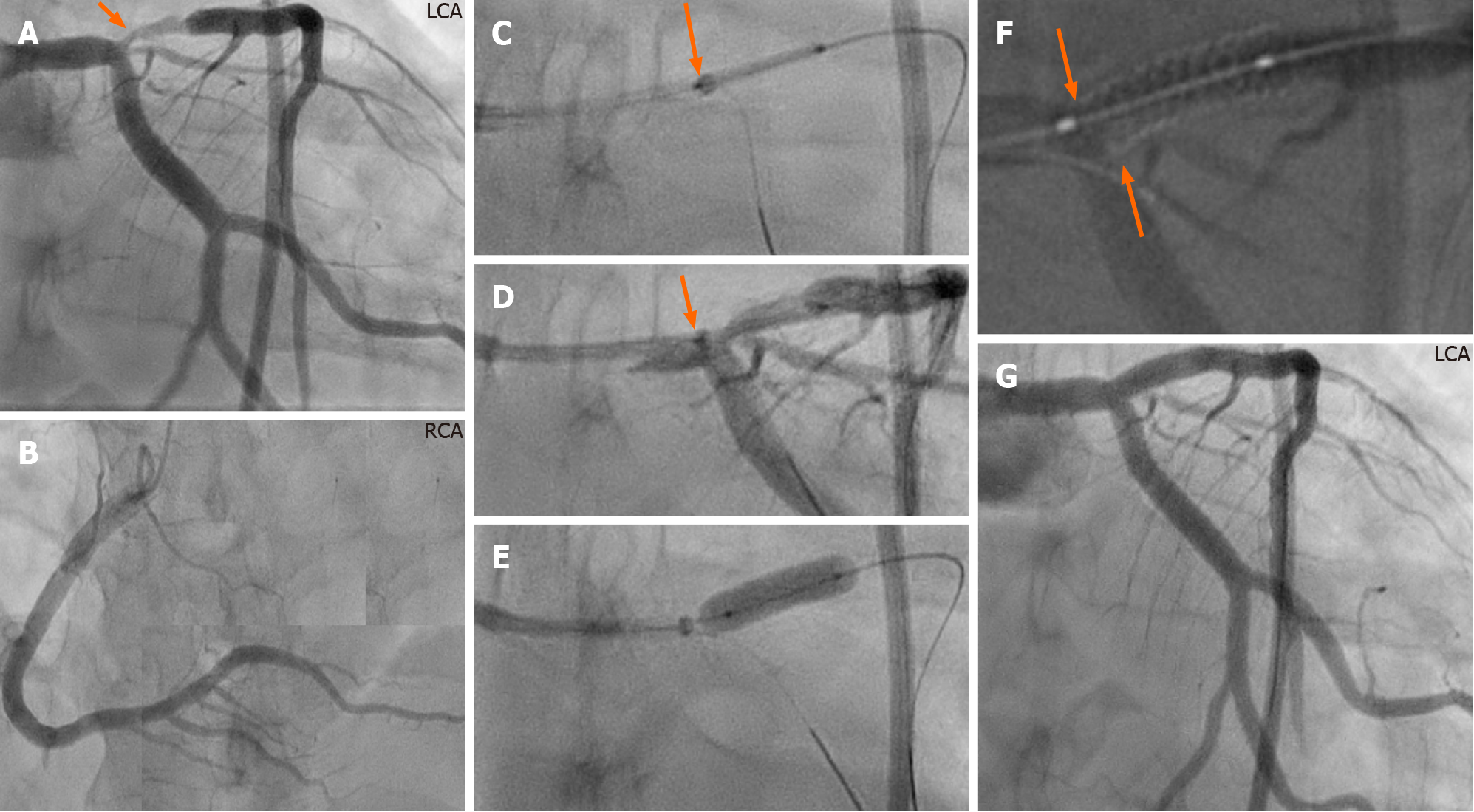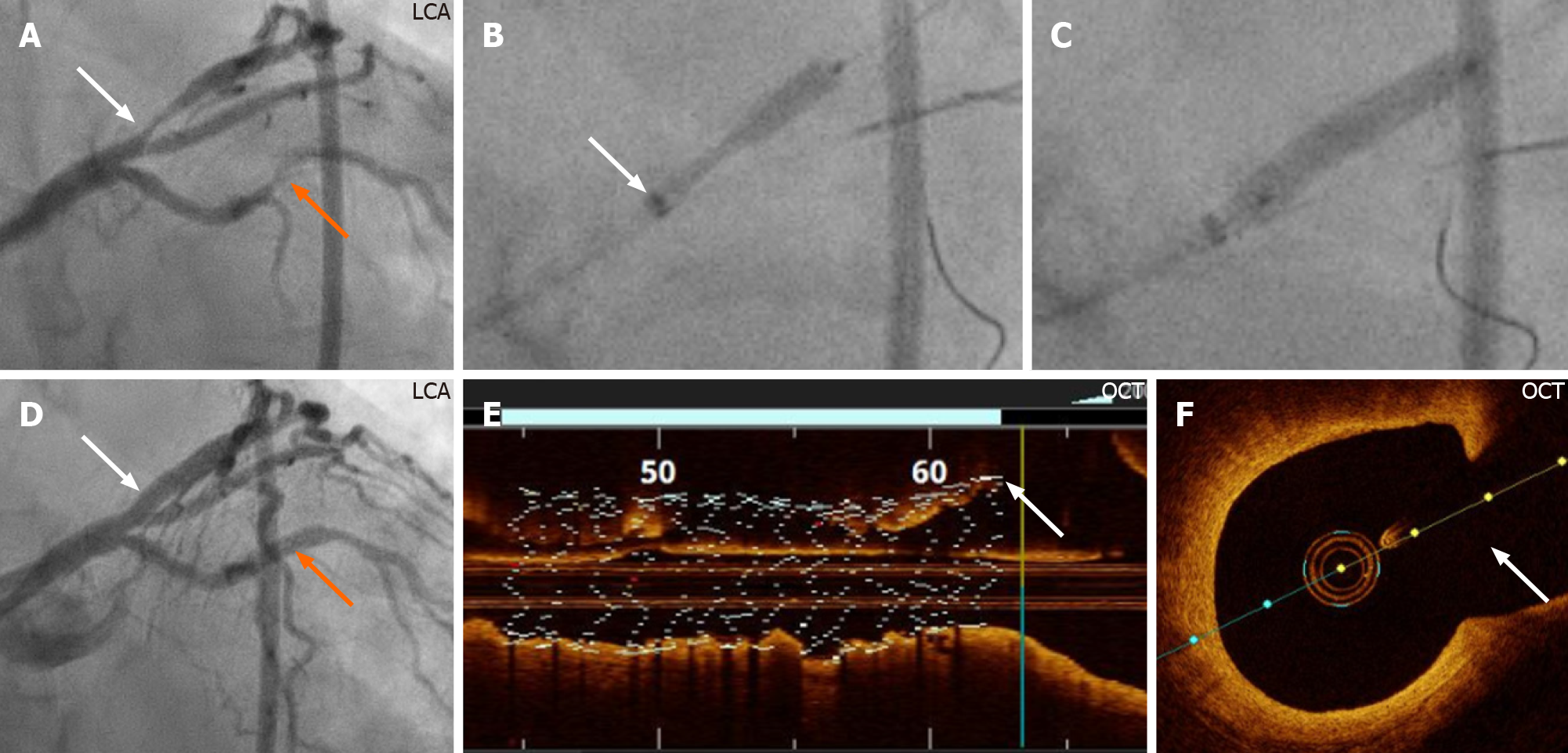Copyright
©The Author(s) 2021.
World J Cardiol. Jun 26, 2021; 13(6): 155-162
Published online Jun 26, 2021. doi: 10.4330/wjc.v13.i6.155
Published online Jun 26, 2021. doi: 10.4330/wjc.v13.i6.155
Figure 1 Schematic description of the guide extension-assisted technique in a coronary bifurcation lesion in the first case.
A: Coronary angiography in a male patient admitted with unstable angina revealed a significant ostial and proximal left anterior descending artery (LAD) stenosis. It was classified as side branch mono-ostial (medina 0, 0, 1), left main stem/left circumflex artery (LCx)/LAD bifurcation stenosis (orange arrow). Evaluation by fractional flow reserve assessment was 0.76, indicating a significant stenosis. The guide extension-assisted percutaneous coronary intervention technique is demonstrated schematically. B: Two guide wires are placed in the left coronary artery (both LAD and LCx); C: After conventional pre-dilatation, the GuideLiner, mounted on both guidewires, is placed proximal to the tip of the mother guide catheter (orange arrow); D: The stent is introduced just distal to the stenosis; E: The GuideLiner is then advanced to the carina of the bifurcation and the stent is pulled back to a level where the proximal radio-opaque marker of the stent balloon overlaps the radio-opaque marker just proximal to the tip of the guide-liner (orange arrow). Because the GuideLiner is mounted on both wires, the carina of the bifurcation will prevent further introduction of the GuideLiner into the LAD or LCx; F: The stent is implanted slowly. Note that the GuideLiner is pushed backwards when the stent balloon is inflated.
Figure 2 Annotated description of the guide extension technique in the bifurcation lesion in the first case.
A and B: Left (A) and right (B) coronary angiography of the same patient in figure 1 showing stenosis at the ostium and proximal part of left anterior descending artery (LAD) (A, orange arrow); C and D: After engagement of the left coronary artery with 7F XB 3.5 guide catheter, a 7F GuideLiner, mounted on both guidewires, is advanced carefully against the carina of the bifurcation and the stent is placed at the stenosis site with the proximal radio-opaque marker of the stent balloon overlapping the radio-opaque marker just proximal to the tip of the GuideLiner (D, under contrast injection); E: A 3.5 mm × 15 mm stent was implanted with a pressure of 20 atm; note that the GuideLiner is pushed backwards during stent implantation. The stent is post-dilated in the conventional way; F: The proximal stent edge can be seen accurately placed at the ostium using StentBoost imaging (orange arrows); G: Final result, stent implanted in the LAD without compromising the left main stem or the left circumflex artery ostium. LCA: Left coronary artery; RCA: Right coronary artery.
Figure 3 Demonstration of the guide extension technique during percutaneous coronary intervention of the bifurcation lesion of the second case.
A: Left coronary artery (LCA) angiography reveals a stenosis in the obtuse marginal branch, (orange arrow) that was stented first after engagement of the left coronary artery with 7F-XB 3.5 guide catheter. There is also a distal mono-ostial (medina 0, 1, 0) left anterior descending artery (LAD)/diagonal bifurcation stenosis (white arrow), which was stented with the guide extension-assisted technique; B: Of note, angiography to visualize the angle between the diagonal branch and the distal segment of the main branch (LAD) was ambiguous, making it especially suitable for this novel technique. The GuideLiner, mounted on both the LAD and diagonal guidewires, was introduced to the carina site of the bifurcation. A Promus Premier 3.0 mm × 16 mm stent (Boston Scientific, Marlborough, MA, United States) positioned at the stenosis with the proximal stent balloon radio-opaque marker positioned on the GuideLiner radio-opaque marker just proximal to the tip of the GuideLiner (white arrow); C: The stent was implanted at a pressure of 22 atm; D: Angiographic final result (white and orange arrows); E and F: The implanted stent, checked by using OCT, is well-apposed to the vessel wall; the proximal stent edge can be seen positioned at the ostium of the distal segment of the main branch (E, white arrow), and no stent struts are seen to cover the diagonal branch ostium (F, white arrow). OCT: Optical coherence tomography.
Figure 4 Demonstration of the guide extension technique in a complex true bifurcation lesion in the third case.
A and B: Left (A) and right (B) coronary angiography. The left anterior descending artery (LAD) system reveals a proximal tri-ostial (medina 1, 1, 1) LAD/diagonal bifurcation stenosis where the LAD is subtotally occluded (thick orange arrows); B: The distal part of the LAD is filled by collateral circulation from the right coronary artery (thick orange arrow); C: The left coronary artery engaged with 7F-XB 3.5 guide catheter. After placing two guidewires, one in the LAD and another in the diagonal artery, and then conventional predilatation of both the main and the side branches, the GuideLiner, mounted on both guidewires, is positioned at the bifurcation carina. A Promus Premier (Boston Scientific, Marlborough, MA, United States) 2.5 mm × 16 mm stent is placed in the diagonal artery; D and E: The stent is retracted so that the proximal stent balloon radio-opaque marker overlaps the radio-opaque marker just proximal to the tip of the GuideLiner (D: Without contrast; E: With contrast; orange arrows); F: The stent was implanted at a pressure of 22 atm; the stent balloon pushes the guide extension catheter backwards; G: StentBoost imaging (Philips Medical Systems, Eindoven, the Netherlands) shows that the proximal stent edge is positioned at the side-branch ostium. After stent implantation in the main branch with a Promus Premier (Boston Scientific, Marlborough, MA, United States) 3.0 mm × 24 mm stent post-dilated with a 3.5 mm high pressure balloon, rewiring of the side branch, sequential balloon dilatation, proximal optimization technique, and final kissing balloon inflation; H: StentBoost imaging reveals a precisely stented bifurcation lesion without unnecessary layers of struts; I and J: Optical coherence tomography confirmed a well-apposed stent and no struts covering the ostium of the diagonal artery (orange arrows); K: Final result (orange arrow). LCA: Left coronary artery; RCA: Right coronary artery.
- Citation: Y-Hassan S, de Palma R. A Novel guide extension assisted stenting technique for coronary bifurcation lesions. World J Cardiol 2021; 13(6): 155-162
- URL: https://www.wjgnet.com/1949-8462/full/v13/i6/155.htm
- DOI: https://dx.doi.org/10.4330/wjc.v13.i6.155












